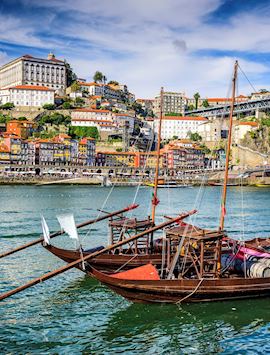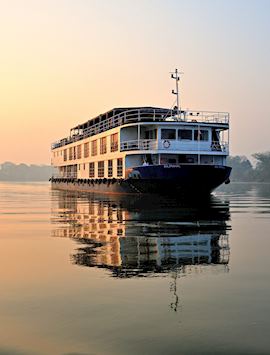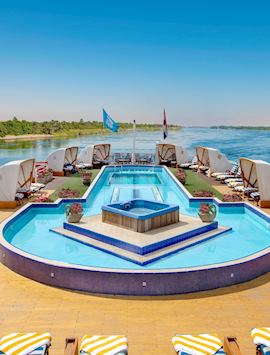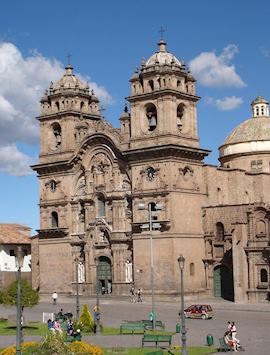Watching daily life unfold in tiny villages along the Mekong… Exploring still-vibrant tombs in the Valley of the Kings... Spotting sloths and bright-feathered macaws in Amazonian rainforests... Rivers have defined civilizations since before the written word and remain one of the best ways to explore many destinations.
What’s more, by combining time spent on both land and water, you get a deeper perspective on the people and places that dot these great rivers’ shores. Here, we offer six reasons to include a river cruise as part of your next Audley trip.
Short sailing times between ports

Castles and vineyard, villages and cities. The sights along a river are densely packed, often with only a few hours of sailing separating them. That means you'll regularly wake up already docked and have long evenings in port before you return to your ship.
The result? Plenty of time to explore. Like in Portugal's Douro Valley, where vineyards and quintas (wine estates) are stacked along the riverbanks as close as pearls on a string. At each stop, you’ll have ample time to enjoy the sights, whether that’s a wine-paired lunch at a family-run estate or a hike up the holy staircase of Lamego.
A relaxing way to travel

When you board a river boat, you’ll unpack just once. Instead of constantly navigating departure timetables, meeting your private drivers, and checking into new hotels, you’ll settle in for a leisurely exploration. We think it’s one of the most relaxing ways to explore while still taking in a wide range of places.
For example, on our West Bengal cruise, you’ll board in Calcutta and head north on the Hugli. This takes you to part of Bengal that you otherwise wouldn’t be able to visit easily. Along the way, you’ll have plenty of time to soak up the sights, from Hazarduari Palace in Murshidabad to mango orchards in sleepy Baranagar and even far-flung Gaur, once one of India's greatest cities.
Expert excursions in port

Whether they’re remote villages, far from major roads, or simply out-of-the way sights, river cruising often means you’ll visit places that are harder to see if you’re not on the water. And at each stop you’ll be able to explore with the ship’s expert guides.
Few places better exemplify this than Philae Temple, one of the highlights of a leisurely Nile cruise. Your English-speaking guide will take you into the pretty temple and explain its fascinating history, both ancient and modern.
Sacred to Isis, this was likely the last place of worship dedicated to ancient Egyptian mythology, and it marked the southern boundary of the empire. You’ll also hear about the fascinating modern history and the enormous effort undertaken to save it from destruction.
Scenic views from deck

Around the world, rural communities have long depended on the life-giving waters of rivers, which is why villages cluster near their banks. A cruise gives you a front seat view of this life, where timeless tableaus are still unfolding.
For example, the scenes that unscroll along the banks of the Mekong aren’t much different than those that you might have seen centuries ago — palm trees, rice paddies, wooden floating villages, and fishermen wielding nets. You’ll pass villages where women still weave in traditional ways and pull up to fruit farms to buy rambutan, and even board a traditional sampan to visit bamboo forests at Ben Tre.
Smooth sailing

Even the very best ocean-faring ships still rock a bit on waves, especially in high seas. If you’re prone to seasickness, however, river cruises are very much an option. Contained by banks and (usually) far from stormy seas, these journeys typically are smooth sailing.
Add to that the ships’ wide flat keels and low profiles and you rarely deal with the side-to-side movement that causes problems on the high seas.
As an example, a cruise along the Peruvian tributaries of the Amazon usually encounters placid waters. It’s an exceptional way to explore the far reaches of the rainforest and glimpse rarely seen wildlife. It also complements a visit to the Sacred Valley, providing a more complete experience of the region.
Small ships

The ships that ply the world’s waterways are as varied as the destinations themselves. You might take a luxe Egyptian ship with all the modern amenities, a colonial-style Thai boat down the Irrawaddy, or even a rice barge-turned-houseboat down the backwaters of Kerala. Regardless, you’ll find intimate ships with attentive service and few others — in some cases, your party will be the only guests.
Our specialists have extensive experience with the ships and can walk you through all your options to find the one that suits you best.







